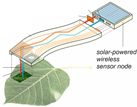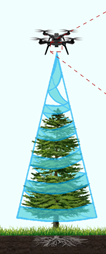Research Area B - active chlorophyll fluorescence measurements as a sensitive stress parameter addressing the relevance of microclimatic heterogeneity
Area B will use chlorophyll fluorescence (ChlF) as a sensitive parameter to trace effects on environmental changes and biotic and abiotic stresses on the photosynthetic efficiency, ranging from leaf-based networks up to canopy and forest stand. We will identify hot spots and hot moments of stress impact in the heterogeneous forest canopies.
B1 Wireless, energy-autonomous chlorophyll fluorescence (ChlF) measurement in tree canopies using flexible, multifunctional and highly integrated microsensor probes
B1.1 Spatio-temporal heterogeneity of leaf chlorophyll fluorescence
We will capture the spatio-temporal heterogeneity in leaf-level chlorophyll fluorescence (ChlF), a sensitive tool of photosynthetic efficiency and plant stress. Together with microclimatic measurements we will record a novel dimension of a spatial network within and among tree canopies, to efficiently identify hot spots and hot moments of stress-induced changes of photosynthetic efficiency.
Open positions: currently there are no open positions in this subproject.
PI: Prof. Dr. Christiane Werner
B1.2 Minimally Invasive and Energy-Aware Multifunctional Leaf Sensors
We will develop novel wireless, energy-autonomous ChlF sensors, using flexible, multifunctional (microclimate), and highly integrated microsensor probes. The new leaf sensor (<1cm²) will have the highest degree of miniaturization, to ensure the least interference with leaves. These sensors will act as independent sensor nodes, due to solar energy harvesting enabling them to communicate their data wirelessly, and can be installed at in a deploy-and-forget strategy.
Open positions: currently there are no open positions in this subproject.
More information will follow shortly
PIs: Prof. Dr. Stefan J. Rupitsch, Dr. Laura Comella
B2 Remote assessment of chlorophyll fluorescence (ChlF) as indicator for canopy vitality using UAVs with robust lightweight instrumentation
B2.1 4D-canopy-vitality using structural and active ChlF data from UAV-based remote sensing
We will use remote assessments of active ChlF via an unmanned aerial vehicle (UAV) to generate detailed repeated spatial maps to visualize and assess tree vitality, identify hot spots within the forests and transfer the sample based findings into area wide monitoring. In doing so, we will further develop the models for chlorophyll fluorescence assessment based on UAV carried remote sensing devices, calibrated against the tree leaf measurements.
Open positions: currently there are no open positions in this subproject.
PIs: Prof. Dr. Barbara Koch, Dr. Anna Göritz
B2.2 Lightweight robust versatile instrumentation for active canopy fluorescence measurements with leaf-level resolution from UAV
We will develop a strongly miniaturized, highly integrated lightweight UAV-based active ChlF measurement using LiDAR (Light detection and ranging) techniques with an efficient new scanning paradigm. It will allow for largely extended flight campaigns with high spatial resolution. Thereby, the calibration of the UAV borne data will directly profit from the leaf sensor network of B1.
Open positions: currently there are no open positions in this subproject.
PIs: Prof. Dr. Ulrike Wallrabe, Prof. Dr. Alexander Reiterer

